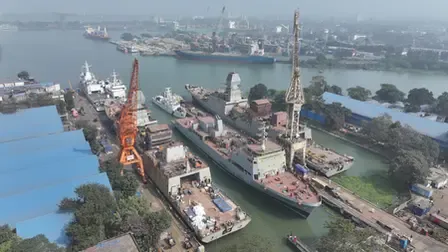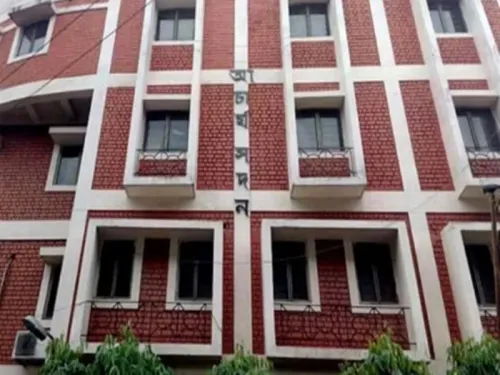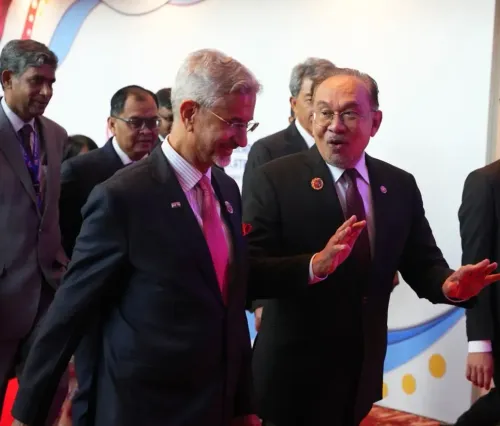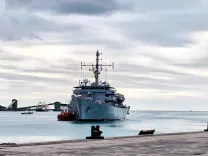Is India Set to Lead with Over Rs 3 Lakh Crore in Maritime Vision 2030?

Synopsis
Key Takeaways
- India's total port capacity has nearly doubled from 1,400 MMTPA to 2,762 MMTPA.
- Annual surplus in the maritime sector has surged from Rs 1,026 crore to Rs 9,352 crore.
- Cargo handling volumes increased from 972 MMT to 1,594 MMT, showcasing robust trade growth.
- Maritime Development Fund to provide Rs 25,000 crore for shipping and shipbuilding expansion.
- India Maritime Week 2025 expected to attract over 100,000 delegates from more than 100 countries.
New Delhi, Oct 26 (NationPress) Steering towards a transformative decade from 2014 to 2025, India’s maritime industry is making significant strides, showcasing remarkable achievements in ports, coastal shipping, and inland waterways, as highlighted in an official statement released on Sunday ahead of India Maritime Week 2025, commencing in Mumbai on Monday.
This progress is driven by Maritime India Vision 2030, which is supported by an investment ranging from Rs 3 to 3.5 lakh crore aimed at modernizing ports, enhancing shipping capabilities, and fortifying inland waterways. A noteworthy package of Rs 69,725 crore is currently being implemented to bolster shipbuilding and rejuvenate the maritime ecosystem.
India’s port sector has experienced a remarkable transformation, with overall port capacity almost doubling from 1,400 million metric tonnes per annum (MMTPA) to 2,762 MMTPA, showcasing substantial investments in modernization and infrastructure.
The financial health of the sector has strengthened, with net annual surplus increasing sharply from Rs 1,026 crore to Rs 9,352 crore, highlighting improved revenue generation and cost management, as stated.
Efficiency metrics have also seen significant improvement, with the operating ratio enhancing from 73 percent to 43 percent, marking a crucial advancement towards sustainable and profitable port operations.
Cargo handling volumes have impressively surged from 972 million metric tonnes (MMT) to 1,594 MMT, indicating robust growth in maritime trade and port efficiency, with major ports managing roughly 855 million tonnes of cargo in FY 2024-2025, an increase from 819 million tonnes in FY 2023-24.
Operational performance has shown notable improvement, as the average vessel turnaround time has dipped from 93 hours to merely 48 hours, boosting overall productivity and global competitiveness.
The shipping sector has charted steady growth, with the number of Indian-flagged vessels increasing from 1,205 to 1,549, reflecting India’s expanding maritime footprint.
The gross tonnage of the Indian fleet has risen from 10 million gross tonnes (MGT) to 13.52 MGT, signifying enhanced shipping capacity.
Coastal shipping has gained significant traction, with cargo movement nearly doubling from 87 million metric tonnes (MMT) to 165 MMT, reinforcing the shift towards efficient, low-cost, and eco-friendly transport methods.
In a groundbreaking development for the inland water transport sector, the Inland Waterways Authority of India (IWAI) reported record cargo movement of 146 MMT in 2025, up from 18 MMT in 2014, marking an increase of around 710 percent.
The operational waterways have impressively grown from 3 to 29, signifying a major enhancement to India’s inland transport network.
IWAI has handed over the Haldia Multi-Modal Terminal (MMT) to IRC Natural Resources, marking a significant step in advancing inland waterway infrastructure and promoting multimodal logistics under the Public-Private Partnership (PPP) framework. Developed with assistance from the World Bank, the West Bengal terminal boasts a capacity of 3.08 million metric tonnes per annum (MMTPA).
Ferry and Ro-Pax services have also gained substantial popularity, transporting over 7.5 crore passengers in 2024-25, highlighting the growing public shift towards water-based transport for safe and efficient travel.
In just a decade, India’s seafarer workforce has surged from 1.25 lakh to over 3 lakh, now comprising 12 percent of the global seafaring workforce, positioning the country among the top three suppliers of trained seafarers and opening vast opportunities in navigation, ship operations, logistics, and related maritime sectors both domestically and internationally.
With a corpus of Rs 25,000 crore, the Maritime Development Fund (MDF) is poised to provide long-term financing aimed at expanding India’s shipping tonnage and shipbuilding capacity. In parallel, the revamped Shipbuilding Financial Assistance Scheme, with an allocation of Rs 24,736 crore, addresses domestic cost challenges and incentivizes ship-breaking, while the Shipbuilding Development Scheme promotes greenfield clusters, yard expansions, and risk coverage with Rs 19,989 crore.
India Maritime Week 2025 (IMW 2025) is a pivotal event in the global maritime calendar, scheduled from October 27 to 31 at the NESCO Exhibition Centre, Mumbai. Uniting key stakeholders from the shipping, port, and logistics sectors, IMW 2025 will serve as a strategic platform fostering dialogue, collaboration, and business development. The event is expected to attract participants from over 100 countries and draw more than 100,000 delegates, including port operators, investors, innovators, and policymakers. The five-day program will feature 500 exhibitors, thematic pavilions, technology demonstrations, and sessions covering port-led development, shipbuilding clusters, and digital corridors.









